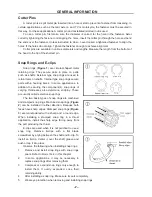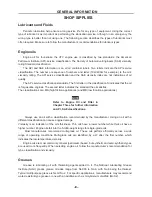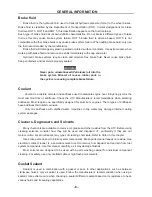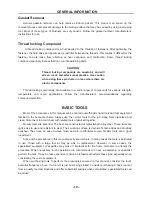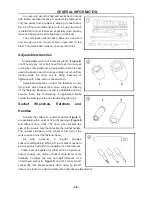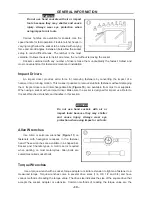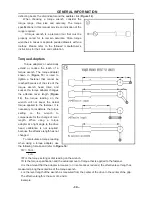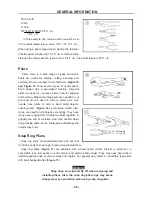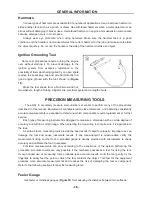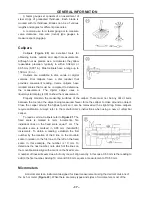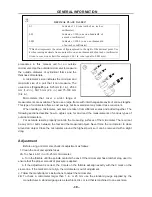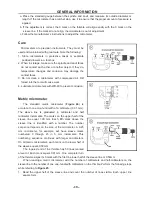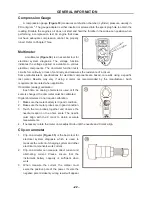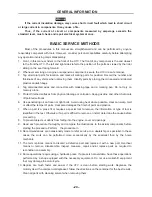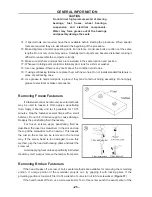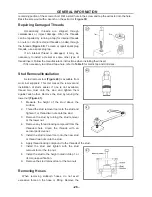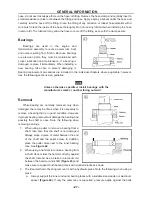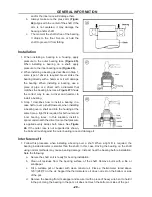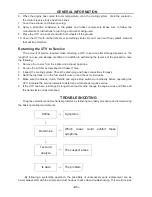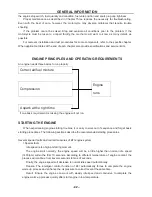
-18-
GENERAL INFORMATION
- 18 -
procedures in this manual call for an outside
micrometer. Use the outside micrometer to measure
the outside diameter of cylindrical forms and the
thickness of materials.
A micrometer’s size indicates the minimum and
maximum size of a part that it can measure. The
usual sizes (
Figure 23
) are 0-25mm (0-1 in.), 25-50
mm (1-2 in.), 50-75 mm (2-3 in.) and 75-100 mm
(3-4 in.).
Micrometers that cover a wider range of
measurements are available. These use a large frame with interchangeable anvils of various lengths.
This type of micrometer offers a cost savings, but its overall size may make it less convenient.
When reading a micrometer, numbers are taken from different scales and added together. The
following sections describe how to adjust, care for and read the measurements of various types of
outside micrometers.
For accurate results, properly maintain the measuring surfaces of the micrometer. There cannot
be any dirt or burrs between the tool and the measured object. Never force the micrometer to close
around an object. Close the micrometer around the highest point so it can be removed with a slight
drag.
Adjustment
Before using a micrometer, check its adjustment as follows:
1. Clean the anvil and spindle faces.
2A. To check a 0-1 in. or 0-25 mm micrometer:
a. Turn the thimble until the spindle contacts the anvil. If the micrometer has a ratchet stop, use it to
ensure that the proper amount of pressure is applied.
b. If the adjustment is correct, the 0 mark on the thimble will align exactly with the 0 mark on the
sleeve line. If the marks do not align, the micrometer is out of adjustment.
c. Follow the manufacturer’s instructions to adjust the micrometer.
2B. To check a micrometer larger than 1 in. or 25 mm use the standard gauge supplied by the
manufacturer. A standard gauge is a steel block, disc or rod that is machined to an exact size.
DECIMAL PLACE VALUES*
0.1
Indicates 1/10 (one tenth of an inch or
millimeter)
0.01
Indicates 1/100 (one one-hundredth of
an inch or millimeter)
0.001
Indicates 1/1000 (one one-thousandth
of an inch or millimeter)
*This chart represents the values of figures placed to the right of the decimal point. Use
it when reading decimals from one-tenth to one one-thousandth of an inch or millimeter.
It is not a conversion chart (for example: 0.001 in. is not equal to 0.001 mm).
Summary of Contents for HS200UTV
Page 3: ......
Page 15: ......
Page 94: ... 79 SPECIFICATIONS 79 HYDROGRAPHIC CHART Hydrographic chart Pressure ...
Page 95: ... 80 SPECIFICATIONS 80 LUBRICATION OIL WAY LUBRICATION OIL WAY Pressure splashing oil ...
Page 248: ... 233 CHASSIS 233 Fuel tank cap Remove the fuel tank cap by turning it counterclockwise ...
Page 263: ... 248 ...
Page 304: ... 289 ...
Page 305: ... 290 ...
Page 306: ... 291 ...
Page 307: ... 292 ...
Page 308: ... 293 ...
Page 309: ... 294 ...
Page 310: ... 295 ...
Page 311: ... 296 ...




